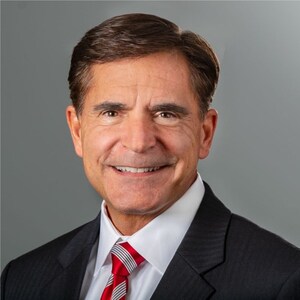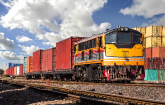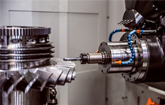Greenbrier announces new orders for 5,400 railcars valued at $575 million
~ Orders broad-based across a range of railcar types
~~ Momentum in automotive carrying equipment continues
LAKE OSWEGO, Ore., March 27, 2013 /PRNewswire/ -- The Greenbrier Companies, Inc. [NYSE:GBX] announced today that it received new orders in January, February, and March for 5,400 railcar units valued at approximately $575 million.
To view the multimedia assets associated with this release, please click http://www.prnewswire.com/news-releases/greenbrier-announces-new-orders-for-5400-railcars-valued-at-575-million-200279611.html
These orders are broad-based across a range of railcar types including automotive-related rail products, tank cars, double-stack intermodal platforms, boxcars and various types of covered hopper cars. Continued strength in energy and industrial chemical markets led to orders for nearly 2,700 of Greenbrier's higher margin tank cars. The Company also received orders for over 700 automotive-related rail products including 89-foot flatcars and the Company's proprietary Multi-Max™ auto racks in North America, and for open and closed car carriers in Europe. The remaining orders are for double-stack intermodal platforms, boxcars, mill gondola cars and covered hopper cars, including an initial order for the Company's new plastic pellet car.
The new orders are in addition to the orders for 4,200 railcars valued at $430 million reported in Greenbrier's press release dated January 7, 2013. Since September 1, 2012, the beginning of the fiscal year, Greenbrier has received orders for nearly 9,600 railcars in North America and Europe valued at over $1 billion, consisting of approximately 4,000 tank cars, 2,100 automotive-related flatcars or racks, and with the balance across a broad range of other railcar types.
William A. Furman, president and chief executive officer of Greenbrier said, "Our railcar manufacturing strategy is to diversify our new railcar product offerings, to reduce reliance on a single commodity or railcar type at any given time and to benefit from growth in demand for various railcar types, including tank cars, frac sand cars, and plastic pellet cars for the rapidly expanding North American energy and chemicals markets. This strategy continues to bear fruit. As these orders demonstrate, we are able to flexibly and nimbly respond to emerging trends and to our customers' varied railcar needs with a flexible and geographically diverse manufacturing footprint."
TANK CARS
Furman also noted, "The strength in the energy markets continues to produce strong demand for our higher margin tank cars. Industry forecasts indicate tank car demand is expected to continue to be robust through 2015, and then settle back to baseline levels. We continue to ramp up our tank car production to meet this demand. By the end of calendar year 2013, we expect to be at an annual production rate of about 3,800 tank cars, nearly four times our fiscal 2012 production. Industry forecasts also indicate the rebounding economy and independent growth in certain commodities will continue to drive increasing demand for non-energy related railcars including intermodal, forest products, automotive, covered hopper and other car types where Greenbrier has been historically strong."
AUTOMOTIVE
"Automotive is an especially exciting part of our business today. Railroads carry approximately 70% of all new vehicles manufactured in North America. Over the next three years, independent industry forecasts project that deliveries of automotive-related railcars will exceed 10,000 units in North America, with an equivalent number of racks being built. This demand is being driven by growth in automotive traffic by rail as a result of growing auto sales and a geographic shift in production of autos. Simultaneously, an aging fleet of automotive carrying railcars with an average age of approximately 20 years, and a 10% reduction in size of the automotive carrying railcar fleet in North America since 2009, is driving a railcar replacement cycle. This fleet of automotive equipment consists of about 50,000 railcars, each equipped with racks, either unitized with the flatcar, as in the case of Auto-Max®, or with fully-enclosed, detachable racks. Most conventional 89' cars for automotive service are owned by TTX, the national railroad-owned freight car pool operator. Racks are owned predominantly by railroads, shippers or leasing companies," Furman continued.
Furman added, "Greenbrier is well-positioned to meet this growing demand. We have the most comprehensive line of products for transport of finished vehicles by rail, with three distinct designs in North America: Auto-Max, an articulated, fully integrated 2-unit railcar with flexible bi-level and tri-level configurations; Multi-Max, a new proprietary automotive rack with flexible bi-level and tri-level configurations; and a standard 89' flatcar for bi-level or tri-level rack service capable of taking either a conventional rack or Multi-Max. Both Auto-Max and Multi-Max utilize important features of our innovative double-stack technology that offers superior versatility, flexibility, and increased load capacity. Both also feature a proprietary sealed end-door that offers industry-leading cargo security and enhanced loading door edges for unmatched vehicle safety and protection in long-distance transit. This is particularly important for service in Mexico. We are pleased with our position in Europe, as well, where we are the leading automotive rail manufacturer from our Polish facility, having produced over 1,800 automotive railcars in the last five years."
Furman stated, "U.S. light vehicle sales increased by 13% in 2012 from 2011. For the first time in five years, sales are forecast to exceed 15 million light vehicles in 2013, with continued sales growth forecast through 2016. Mexico recently surpassed Japan as the largest exporter of light vehicles to the United States and is forecast to increase its share of North American light vehicle production substantially over the next decade. This demographic shift will further support growth in automotive rail loadings, with rail as the preferred transportation method of light vehicles manufactured in Mexico. Greenbrier's automotive line of products is also manufactured in Mexico, and we are uniquely equipped at our low-cost and flexible facilities to take advantage of this geographic shift. At the same time, automotive rail loadings are up 16% from 2011 to 2012 in the United States and are forecast to increase in each of the next three years, all helping fuel demand for our automotive products."
ROBUST CAR LOADINGS TO DRIVE DEMAND FOR DIVERSIFIED PRODUCT OFFERINGS
Furman concluded by saying, "North American railroad loadings, excluding coal and agriculture and including intermodal, are up nearly 6% for the 11 weeks ending March 16, 2013 compared to the same period in 2012. A number of sectors which Greenbrier serves, beyond automotive, are exhibiting robust traffic growth. Chemical loadings which drive demand for tank cars and large covered hoppers increased 13% in the same period. Loadings of non-metallic minerals and products, transported by small covered hoppers, were up 6% in the period. Finally, 8% growth in intermodal container loadings, which drives demand for double-stack intermodal platforms, led to an order for double-stack wells. Current rail traffic trends are favoring our strategy to be a supplier of diverse railcar types through an efficient and flexible manufacturing footprint."
Mark Rittenbaum, chief financial officer noted, "We remain keenly focused on executing the core aspects of our integrated business model. As management has previously stated, on April 4, 2013, concurrent with the release of our second quarter financial results, we expect to outline actions intended to improve gross margins and capital efficiency, with a view towards improving Greenbrier's return on invested capital and enhancing shareholder value."
Certain orders referenced in this release are subject to customary documentation and completion of terms.
Greenbrier, (www.gbrx.com), headquartered in Lake Oswego, Oregon, is a leading supplier of transportation equipment and services to the railroad industry. Greenbrier builds new railroad freight cars in its four manufacturing facilities in the U.S. and Mexico and marine barges at its U.S. facility. It also repairs and refurbishes freight cars and provides wheels and railcar parts at 39 locations across North America. Greenbrier builds new railroad freight cars and refurbishes freight cars for the European market through both its operations in Poland and various subcontractor facilities throughout Europe. Greenbrier owns approximately 9,000 railcars, and performs management services for approximately 225,000 railcars.
"SAFE HARBOR" STATEMENT UNDER THE PRIVATE SECURITIES LITIGATION REFORM ACT OF 1995: This presentation may contain forward-looking statements, including statements regarding expected new railcar production volumes and schedules, expected customer demand for the Company's products and services, plans to increase manufacturing capacity, new railcar delivery volumes and schedules, growth in demand for the Company's railcar services and parts business, and the Company's future financial performance. Greenbrier uses words such as "anticipates," "believes," "forecast," "potential," "goal," "contemplates," "expects," "intends," "plans," "projects," "hopes," "seeks," "estimates," "could," "would," "will," "may," "can," "designed to," "foreseeable future" and similar expressions to identify forward-looking statements. These forward-looking statements are not guarantees of future performance and are subject to certain risks and uncertainties that could cause actual results to differ materially from in the results contemplated by the forward-looking statements. Factors that might cause such a difference include, but are not limited to, reported backlog is not indicative of our financial results; turmoil in the credit markets and financial services industry; high levels of indebtedness and compliance with the terms of our indebtedness; write-downs of goodwill, intangibles and other assets in future periods; sufficient availability of borrowing capacity; fluctuations in demand for newly manufactured railcars or failure to obtain orders as anticipated in developing forecasts; loss of one or more significant customers; customer payment defaults or related issues; actual future costs and the availability of materials and a trained workforce; failure to design or manufacture new products or technologies or to achieve certification or market acceptance of new products or technologies; steel or specialty component price fluctuations and availability and scrap surcharges; changes in product mix and the mix between segments; labor disputes, energy shortages or operating difficulties that might disrupt manufacturing operations or the flow of cargo; production difficulties and product delivery delays as a result of, among other matters, changing technologies, production of new railcar types, or non-performance of subcontractors or suppliers; ability to obtain suitable contracts for the sale of leased equipment and risks related to car hire and residual values; difficulties associated with governmental regulation, including environmental liabilities; integration of current or future acquisitions; succession planning; all as may be discussed in more detail under the headings "Risk Factors" and "Forward Looking Statements" in our Annual Report on Form 10-K for the fiscal year ended August 31, 2012, and our other reports on file with the Securities and Exchange Commission. Readers are cautioned not to place undue reliance on these forward-looking statements, which reflect management's opinions only as of the date hereof. Except as otherwise required by law, we do not assume any obligation to update any forward-looking statements.
SOURCE The Greenbrier Companies, Inc. (GBX)





Share this article